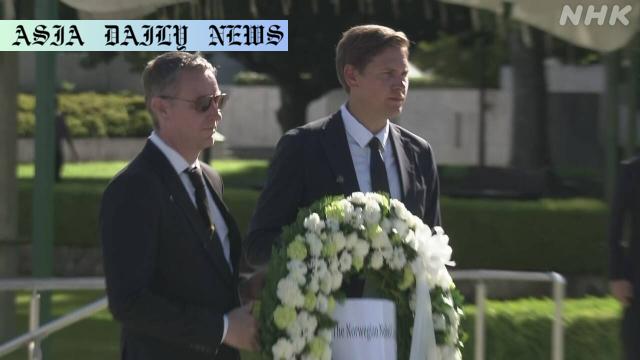Hibakusha Survivors Share Their Stories and Inspire Action
- Norwegian Nobel Committee Chair Joergen Frydnes honors Hiroshima’s atomic bomb victims.
- Frydnes meets hibakusha and highlights the importance of nuclear disarmament.
- High-school peace messengers share their commitment to carrying forward hibakusha stories.
- This visit underscores the need for global awareness and the abolition of nuclear weapons.

Honoring the Legacy of Hibakusha and the Hiroshima Tragedy
The Norwegian Nobel Committee Chair, Joergen Frydnes, took a pivotal trip to Hiroshima, Japan, to pay homage to the victims of the atomic bombing and to connect with hibakusha, a term for the survivors of Hiroshima and Nagasaki. This visit comes as the world reflects on the devastating consequences of nuclear warfare, coinciding with the 80th commemoration year of the bombings. During his visit, Frydnes toured the Hiroshima Peace Memorial Museum, where he witnessed firsthand the harrowing photographs and narratives documenting the destruction caused in August 1945. His reactions underscored the stark reminder that such devastation must never be allowed to recur.
Joining hands with the hibakusha-inspired organization Nihon Hidankyo, Frydnes met with Mimaki Toshiyuki, the Co-Chairperson who had previously represented the group while receiving the Nobel Peace Prize. Their reunion marked a symbolic moment, serving to amplify the collective efforts of hibakusha in urging the abolition of nuclear weapons and promoting a resilient message of peace. Frydnes’s statement that nuclear weapons should never, ever be used again resonates strongly in an era where global discussions on disarmament are critically needed.
Journey of Survivors: A Beacon of Hope for Future Generations
Beyond meeting prominent figures, Frydnes also engaged with other hibakusha and high-school students serving as ‘peace messengers.’ These young advocates play a crucial role in sustaining the legacy and lessons of the hibakusha, ensuring that younger generations understand the gravity of nuclear war and the importance of global solidarity. Frydnes expressed being touched by the passion and determination exhibited by the youth who see themselves as custodians of history and as advocates for nuclear disarmament.
The interactions underscore a generational shift in how the world approaches nuclear disarmament advocacy. Frydnes emphasized the significance of creating a broader awareness this year, marking eight decades since the atomic tragedies, to further cement the message that no nation should endure such a catastrophe again. This highlights the universal message of peace and the unyielding commitment of hibakusha to their cause—reminding humanity of the interconnectedness of our shared future and advocating for cooperation among nations.
Amplifying the Message of Peace: A Global Responsibility
The discussions and activities in Hiroshima reaffirm the urgency of addressing the threat posed by nuclear weapons. The hibakusha’s courage in reliving their traumatic experiences to educate others is a testament to their resilience and dedication to peaceful change. With leaders like Frydnes and organizations like Nihon Hidankyo actively working to amplify their voices, the world is reminded of the catastrophic human cost of nuclear warfare.
This significant visit not only commemorates the unfortunate events of the past but also calls for immediate action to prevent such history from repeating itself. From the halls of Hiroshima’s museums to the passionate advocacy in conferences, the message is clear—nuclear weapons pose an existential threat to global peace, and it is the responsibility of all nations to listen, act, and change the course of history.



Commentary
A Reflection on Frydnes’s Visit to Hiroshima
Joergen Frydnes’s recent visit to Hiroshima carries profound significance, not just for the survivors he met but also for the global campaign against nuclear weapons. At a time when the threat of nuclear arms remains an alarming geopolitical concern, his advocacy serves as both a tribute to the resilience of hibakusha and a rallying call for global disarmament. As he stood in the Hiroshima Peace Memorial Museum, deeply moved by the exhibitions, one can only imagine the weight of history bearing down on him—a reminder of humanity’s capacity for both destruction and renewal.
This momentous year, marking eighty years since the atomic bombings, is an opportunity for reflection and action. Frydnes’s meeting with Nihon Hidankyo’s Co-Chairperson Mimaki Toshiyuki and other hibakusha emphasizes the value of intergenerational dialogue. The hibakusha stories offer humanity a mirror to examine its failings and seek better solutions. Their trauma, shared courageously, is a gift to the world and a plea for lasting peace.
The Importance of Passing the Torch of Peace to Younger Generations
Frydnes’s engagement with high-school peace messengers is another commendable aspect of this visit. By connecting with youth stepping into the role of peace advocates, he underscores the importance of continuity in the mission to abolish nuclear arms. In a world often dominated by political disagreements and the race for power, the voices of educated and empathetic youth offer hope for a future guided by humanity and understanding.
His visit encapsulates the heart of what it means to turn grief into purpose—to take the painful lessons of history and use them to build awareness and foster dialogue. The legacy of the hibakusha, combined with the dedication of newer generations, serves as a blueprint for action, reminding the world that peace is not the absence of conflict but the result of deliberate efforts to avoid destruction.